
Indoor Air Quality for Office Rooms
Computational fluid dynamis is an analysis method developed by using advanced computer technology and numerical calculations as a sub-branch of fluid mechanics. The field of application includes R & D or product development in defense industry, automotive, white goods and aircraft / space industries. Alkazar Engineering, on the other hand, uses this method to meet the needs of the building sector, and treats the building as a product, focusing on developing the design and examining its performance. With this method, in the design stage, different subjects are met with simulations, and in the office, warehouse, atrium volume spaces, the work is carried out to improve the indoor environment quality by means of flow and heat transfer analyzes.
Indoor environmental quality is an important issue for human health and productivity. Today, the most common medical problem that can be seen in office buildings is legionary disease. However, protection from this situation cannot be ensured due to ventilation, and resources in the open area (bacteria, fungi) must be eliminated. Psychological disturbances may also occur, but this may not be highly dependent on office ventilation or air conditioning. Apart from these situations, due to engineering design, air quality, thermal, visual and acoustic loss, occupants may experience discomfort called Sick Building Syndrom (SBS). In people with SBS, this situation is not directly observed, but may occur when leaving the office. Indicators may be fatigue, headache, exhaustion, irritability or eye tension problems. It is observed that the productivity of the people living in these situations stated in the office environment decreases with time and as a result there will be loss of productivity. In order to protect occupant health and to keep productivity high, office interior design has become a subject that requires many different disciplines to work together.
In architectural design, the most appropriate idea for the purpose of use of the office and all other needs are being worked on, while other teams are required to make system design and improvements during the related process. It is a basic assumption that user comfort is one of the important goals in creating a good design. The fact that 40% of the total energy used in the world is devoted to buildings, and that the air conditioning and ventilation consumes 50% of this energy on average brings restrictions on the designs for comfort. The way of a good design dominates the balance between comfort and energy consumption and the necessary calculation methods. is going to be.
The scope of this study; while examining air quality and thermal comfort, acoustical and visual comfort analysis, which are the two other factors constituting the indoor environmental quality as shown in Figure 1, is also important for SBS situation. The complexity of design works is gradually increasing and the standards used for buildings are not sufficient at some points. For this reason, the process of digital testing of the system, which we call performance analysis, gains importance. It can be used both in terms of foreseeing the problems that may occur in investment and providing opportunities for improvement.
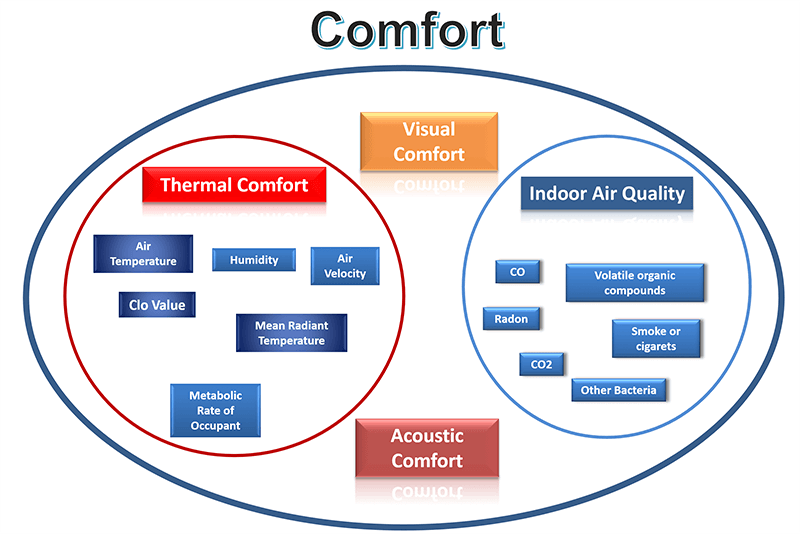
As an example of the above-described definitions and analysis method, this study is aimed to examine how and to what extent the indoor air quality (IAQ) will be affected by the placement of separator materials in the room and on the table used in an office. The study was analyzed with CFD method in a room-specific 3-D format and the numerical values obtained were visualized for easier interpretation.
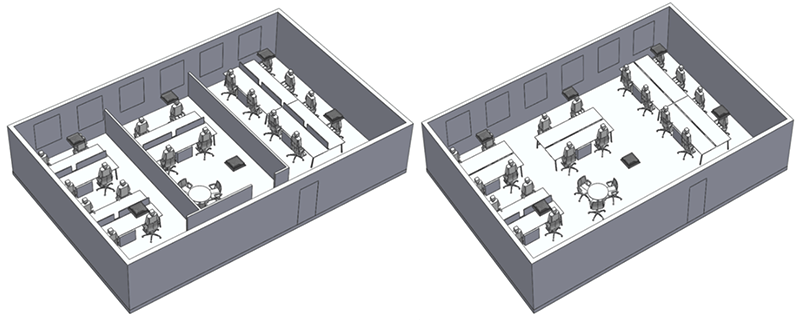
Analysis of studies in Ankara (Turkey) province climate conditions were made with reference to the heating period. It was assumed that the outdoor air temperature was -12 ° C and the heat transfer coefficient was 1.7 W / mK for the walls. The 100 Watt thermal load produced by the human body is taken into account and air conditioning is provided to keep them from getting cold. With a standard diffusers placed under the suspended ceiling and blowing in 4 directions, the hot air was distributed to the environment and taken back into the suspended ceiling and the loop was completed with the fan coil device.
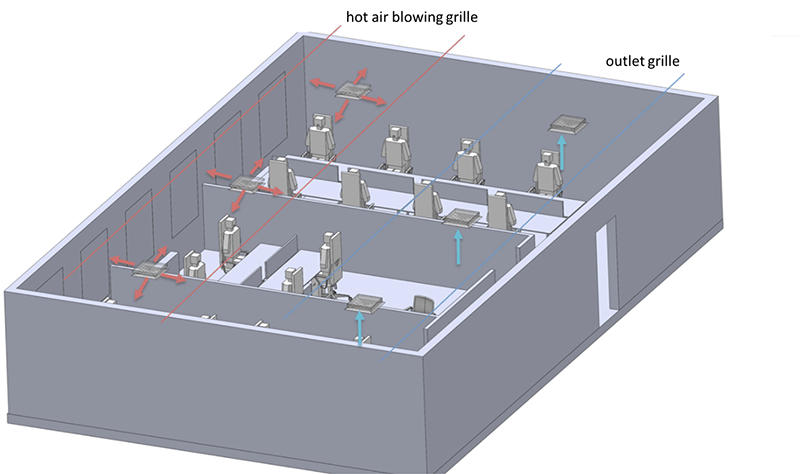
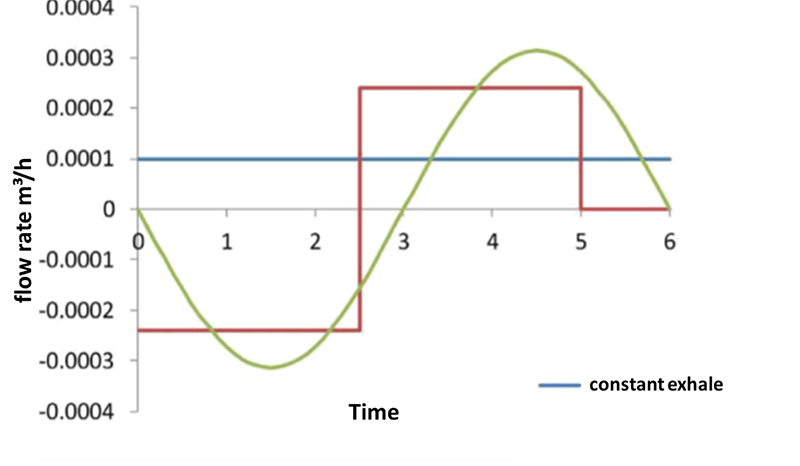
The analyzes based on the assumptions were completed and the numerical results were visualized in sections taken at the average sitting height of the people in the room.
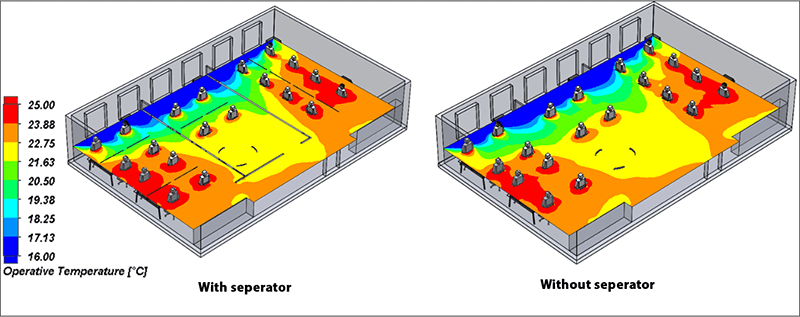

In Figure 6, it is seen that the sensible temperature increases in front of the suction vents due to the rise of the air that is heated in the office and in places where the users sit, it increases above 23°C.
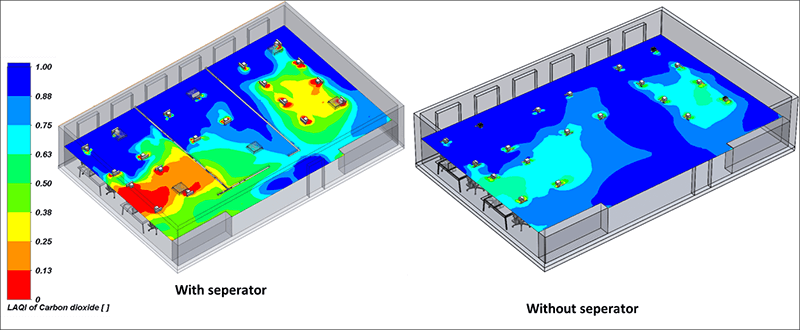
While there is adequate ventilation in the areas indicated in blue in the visual (for legend values of 1 and above), the addition of brackets reveals the need for a more efficient design for office ventilation. In a typical office room where only air conditioning is applied and the door is left open for ventilation, as seen in Figure 7, there is a loss of indoor air quality due to the presence of separating compartments. Since CO2 is heavier than air in molecular weight, it moves close to the ground in the air. There can also be many different external pollutants in real life (not simulation). However, even CO2 gas, one of the main pollutants to be shown, only affects the air quality in the absence of separators, while the addition of other pollutants to the analysis will reduce the quality.



